Anorthosite
Anorthosite: Anorthosite: A leucocratic coarse-grained plutonic rock consisting essentially of plagioclase (usually labradorite or bytownite) often with small amounts of pyroxene. Olivine, amphibole, ilmenite, magnetite, and spinel are also sometimes present.The term anorthosite, from Frenc anorthose (term for plagioclase) was coined by Sterry Hunt. Anorthosite are not particularly abundant on Earth except in a few places like the Grenville Province of the eastern Canadian Shield. As a rock type, it can be stated that anorthosites have formed over the entire range of geological time, and presumably are still forming today. Anorthosite occurrences are quite diverse, and when their distinctive features are used to categorize them, it becomes apparent that some types show very clear temporal restrictions.
Ashwal (1993) categorized anorthosites into six basic types:
1) Archean megacrystic anorthosites, 2) Proterozoic (massif-type) anorthosites, 3) Anorthosites of layered mafic complexes, 4) Anorthosites of oceanic settings, 5) Anorthosite inclusions in other rock types, and 6) Extraterrestrial anorthosites.
Archean megacrystic anorthosites
Archean anorthositic rocks can be found as a minor component of many, but not all Archean greenstone belts, where they are associated with mafic intrusive and extrusive rocks. Where preserved, their primary textures are distinctive, being characterized by equidimensional megacrysts (up to 30 cm diameter) of calcic (usually > An80) plagioclase in a mafic groundmass. A genetic connection between this type of anorthosite and the mafic volcanic rocks of greenstone belts is implied by occurrences of basaltic flows, sills and dikes that contain similar megacrysts of calcic plagioclase, and from the chemical similarities between the basalts and the mafic groundmass surrounding the megacrysts in some anorthosites.
Proterozoic (massif-type) anorthosites
This type is the most abundant of terrestrial anorthosites, occurring as small plutons to batholith-sized composite intrusive complexes up to 15.000-20.000 km2. Some of these larger complexes can be shown to consist of 20 or more individual coalescent plutons. Plagioclase is intermediate in composition (typically An40 or An-60) and occurs as lath-shaped crystals; in some cases, such crystals may reach 1 m across. In addition to intermediate plagioclase, the associated primary minerals of massif-type anorthosite include pyroxene, olivine (or both), Fe-Ti oxides and apatite. Thus age, composition and magmatic texture distinguish Proterozoic massif-type from Archean megacrystic anorthosites. Aside from anorthosite, the dominant rock types of anorthosites massif, include leucogabbro, leuconorite and leucotroctolite, with minor gabbroic rocks. Ultramafic rocks are extremely rare or absent, which led Bowen to consider this mineralogical simplicity in terms of what he called “the problem of the anorthosites”. Spatially associated granitoids, in many cases consisting of charnockites or mangerites, can be shown to represent coeval, but chemically independent magmas, probably produced by crustal melting of country rocks induced by the heat from intrusive anorthosite massifs. This conclusion resolves a major debate of the 20th century regarding the consanguinity of anorthositic and granitic rocks, but the composition of the parental magma for the anorthosites is still uncertain. If it is basaltic, as seems likely from mineralogy and petrology, then a major volume of mafic and ultramafic rock is missing from the present sites of anorthosite exposure. This fact, along with other clues, has led to a widely accepted two-stage model for massif-type anorthosites (Fig.1) that involves deep crustal ponding and fractionation of basaltic melts, sinking of mafic silicates (possibly into the mantle) and strong buoyancy of plagioclase to form flotation cumulates that diapirically rise through the crust as anorthositic mushes. These masses coalesce in the shallow crust to form large composite massifs.

Model for the generation of Massif-type anorthosites. A) Mantle-derived magma underplates the crust as it becomes density equilibrated. B) Crystallization of mafic phases (which sink), and partial melting of the crust above the ponded magma. The melt becomes enriched in Al and Fe/Mg. C) Plagioclase forms when the melt is sufficiently enriched. Plagioclase rises to the top of the chamber whereas mafics sink. D) Plagioclase accumulations become less dense than the crust above and rise as crystal mush plutons.E) Plagioclase plutons coalesce to form massif anorthosite, whereas granitoid crustal melts rise to shallow levels as well. Mafic cumulates remain at depth or detach and sink into the mantle. From Ashwall (1993)
Anorthosites of layered mafic complexes
Layered mafic intrusions range in age from Archean to Tertiary, and commonly contain anorthosites in varying proportions. Commonly, anorthosites form at the tops of modally graded layers on the scale of several meters up to 100 meters or more. Grain size (typically <1 cm) is characteristically smaller than the massif-type or Archean anorthosites, and textures vary from orthocumulates with tabular crysts of plagioclase to adcumulates having equant polygonal grains.
Anorthosites of oceanic settings
Small amounts of anorthosite have been recovered by dredging programs in both mid-oceanic ridge and fracture-zone settings, especially in the Caribbean Sea and the Atlantic and Indian oceans. Ophiolitic anorthosites commonly occur as sharply bounded layers as of those in Layered mafic intrusions. The ages of formation of anorthosite-bearing ophiolite complexes range from late Cambrian to early Eocene.
Anorthosite inclusions in other rock types
Anorthosites also occur as inclusions in other igneous rocks ranging in composition from kimberlite to basalt to granite. Some can be demonstrated to be xenolithic, and represent fragments of other anorthosite types incorporated into ascending magmas. Others, however, are cognate, and represent accumulations of plagioclase from their host magmas.

Archean anorthosite showing megacrysts of calcic plagioclase in a mafic groundmass, Pipestone Lake, Manitoba. From Ashwal (1993).

calcium-rich plagioclase crystals in a anorthosite (larvikite). Photo by Ian Geoffrey Stimpson

Chromitite and anorthosite layers in Critical Zone, UG1 of the Bushveld Complex, in the classic Mononono (formerly Dwars) River outcrop, near Steelpoort, Mpumalanga province, South Africa. Photo by: Kevin Walsh
Bibliography
• Cox et al. (1979): The Interpretation of Igneous Rocks, George Allen and Unwin, London.
• Howie, R. A., Zussman, J., & Deer, W. (1992). An introduction to the rock-forming minerals (p. 696). Longman.
• Le Maitre, R. W., Streckeisen, A., Zanettin, B., Le Bas, M. J., Bonin, B., Bateman, P., & Lameyre, J. (2002). Igneous rocks. A classification and glossary of terms, 2. Cambridge University Press.
• Middlemost, E. A. (1986). Magmas and magmatic rocks: an introduction to igneous petrology.
• Shelley, D. (1993). Igneous and metamorphic rocks under the microscope: classification, textures, microstructures and mineral preferred-orientations.
• Vernon, R. H. & Clarke, G. L. (2008): Principles of Metamorphic Petrology. Cambridge University Press.


.jpg)
.jpg)
.jpg)
.jpg)
.jpg)
.jpg)
.jpg)
.jpg)
.jpg)